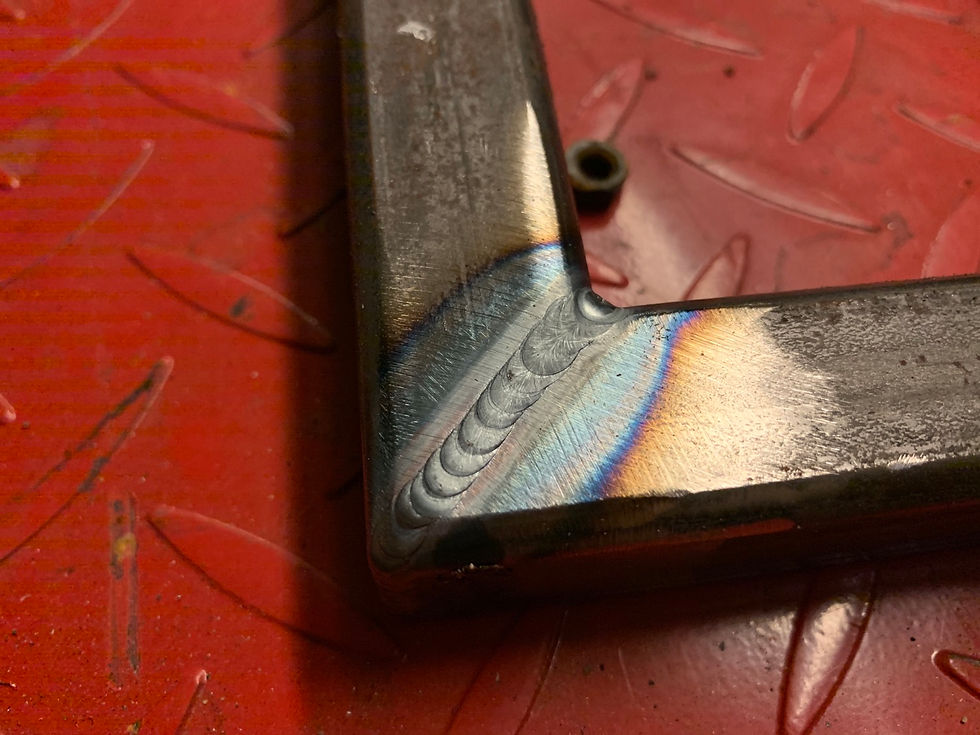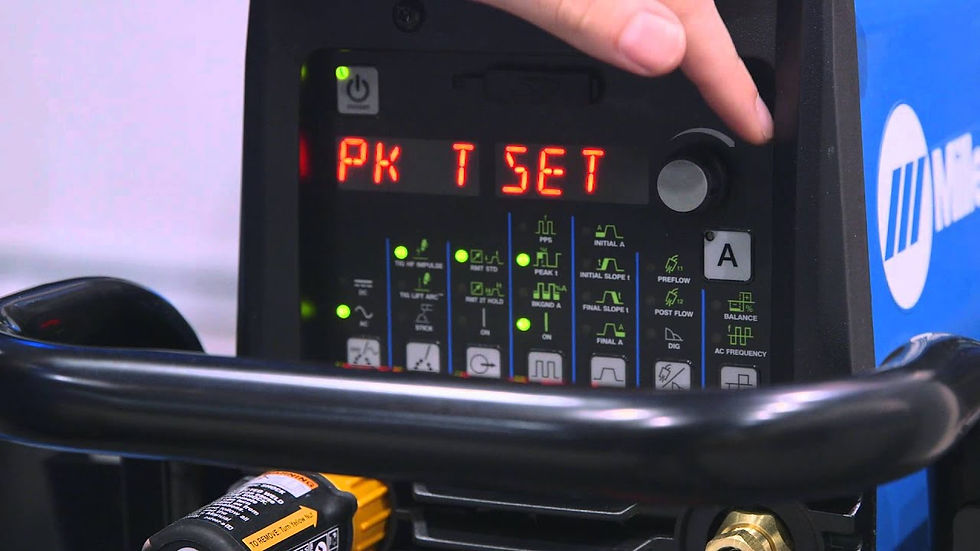Which Filler Wire Do I Need?
- N. Ferro
- Mar 12, 2020
- 6 min read

Ok, so you've purchased your first TIG welder and are eager to start welding. You head to the local welding supply shop to buy filler wire and they ask you what type you want. You freeze up. "What do you recommend?" you ask the person behind the counter who may or may not have any welding experience. They hand you what you hope is the correct wire for your project and you head home with your fingers crossed waiting to see how it goes when you strike that first arc.
This is a story I've heard from several people and came across it in my own research before I got into welding myself. The checkout counter at the welding supply shop is not the place to be making any decisions on what to buy. In this post we'll discuss some of the most important filler wire types and sizes to have on hand so you can tackle whatever job comes your way. I'll break things down based on what types of metals you're going to be welding, and recommend also that you buy a few sizes of each type depending on the thickness of metal you'll be welding.
(Note: One thing to keep in mind before we go any further is what's referred to as a WPS or Welding Procedure Specification. This is a document which lays out exactly how a particular weld is to be carried out, including filler wire, amperage, number of passes and bead height. If you're doing coded work, you MUST follow these requirements. Ignore anything you may read below and refer to your WPS.)
Common Filler Wire Sizes

Let's get this portion addressed first since as I mentioned above, I'd recommend having more than one size of each filler type. I'm based in the United States where we measure filler wire in fractions but I'll include metric equivalents for those of you reading from other parts of the world. There are obviously more sizes than the three I've outlined here, but having these three on hand will allow you to handle most projects that come your way. When I first got started I bought 1/16th first for reasons I'll get into in a moment.
1/16th (1.6mm)
3/32 (2.4mm)
1/8 (3.2mm)
A good rule of thumb for sheet metal projects like gas tanks and fenders is that the filler wire should not be thicker than the material you're welding. Because many of my projects are sheet metal I started with 1/16th filler wire. You might be wondering why we wouldn't want to use a bigger filler wire. Wouldn't it build up the weld more and make the weld stronger? Not exactly...here's why. What happens when you do this is that every time you dab the filler wire into the weld puddle it cools the puddle dramatically. That rapid cooling can prevent your weld from penetrating deeply enough into the joint. Running smaller filler (I like 1/16th for gas tanks) allows the puddle to stay hot to ensure a fully sealed seam. When toeing the line of material thickness between two filler wire sizes, I tend toward using a smaller filler wire because you can always add more filler by dabbing more frequently, but it's almost impossible to add less with each dab.
Choose one or two sizes of each of the types of filler we're going to discuss to get yourself started. You can build up more sizes of each as you progress and determine what types of projects you're doing most often.
Welding Mild Steel to Mild Steel
ER70S-2 & ER70S-6

This is a good place for us to begin as mild steel is one of the most common and most affordable types of metal available. Within mild steel you have "hot rolled" and "cold rolled" steels, but their differences lie more in their strength properties, welding preparation requirements and overall cost than they do in which filler rod is best suited to weld them so we will leave that topic for another post.
When welding mild steel, the two most common rods you'll see used are
ER70-S2 and ER70-S6.

Before getting into the very slight differences between these two rods let me first say that if your local welding supply only carries one of these and not the other, it's fairly safe to say that you'll be fine to use whichever they carry. Unless I was doing coded work which required one over the other, I wouldn't be driving to the next town to get it. My local shop stocks ER70-S2 and that is what I use for nearly all my steel projects. The difference between the two rods is the type of deoxidizers they use. S6 uses higher levels of silicone and manganese while S2 utilizes titanium, zirconium and aluminum. If you're wondering whether that distinction produces enough difference in the weld to notice it, it depends on who you ask. If you're asking me, I don't think so.
Welding Stainless Steel to Stainless Steel
308L & 316L
After playing around with mild steel on a few projects, you'll realize quickly that without paint or powdercoat, your mild steel projects are going to rust pretty quickly, especially at the welds. For this reason, you may want to consider using stainless steel for your next project. The most common stainless steel type you'll encounter in the United States is 304 and is typically welded with 308L filler wire. 316 stainless is the more corrosion resistant (and more expensive) version and is welded with 316L filler wire. If price is a concern, I'd buy 308L filler wire first, since you're likely to be using 304 stainless steel more often than 316. But eventually you'll want to have both on hand just in case.
Welding Mild Steel to Stainless Steel
309L
The key here is to take care of the stainless first. While it may be tempting to use ER70S2 or even 308L, the correct filler wire for welding stainless steel to mild steel is 309L. It was designed specifically for this application and will ensure that the stainless properties remain stainless while also bonding to the mild steel. Obviously you'll still need to protect the portion of the project that is made of mild steel with either paint or powdercoat.
Welding Aluminum
4043 & 5356

When it comes to aluminum, there are many different types of filler wire available for a variety of different applications. To keep you from falling asleep while reading this article we're going to limit our discussion to the two you're most likely to use or see on a WPS. The reason that aluminum filler wire discussions can be a bit lengthy is because many common aluminum alloys (like 6061, a favorite amongst fabricators) can actually be welded with either 4043 or 5356. So what's the difference between them?

In my experience welding aluminum trailer frames, I found 4043 to be easier to weld with. The visual appearance of the weld is better as well. That being said, 5356 has a higher shear strength than 4043, which is why you'll hear some people say 5356 is stronger than 4043. What this leaves out is that certain types of joints, like grooved joints, are more likely to fail in the heated affected zone of the base metal than in the actual weld itself. So the shear strength becomes less of an issue. Additionally, if you're going to be sending these items for anodizing, you'll want to stick to 5356 as 4043 will turn a dark grey/blackish color during the anodizing process and stand out from the rest of the finish. As far as which to get first, consider 4043 for work that's mainly groove welds, and 5356 for for fillets and lap joints and you can make your choice from there.
"Brazing" Steel to Brass
Silicon Bronze
I'm including this section at the end because it's a bit of an oddball. Calling your local welding shop asking for silicon bronze may result in a shop employee brushing away some cobwebs from a closet in the back to dig out a box that hasn't been touched in months. Uncommon as these jobs may be, silicon bronze is actually a very valuable rod to keep around. It will allow you to braze (not weld) dissimilar metals like brass and steel. What's the difference between welding and brazing? In short, welding involves melting the base metal where brazing is actually only melting the silicon bronze filler rod. Isn't that soldering? Almost, but not quite. Brazing is a joining process where the filler metal melts at temperatures above 840 degrees Fahrenheit while the soldering process takes place at temperatures below that. Keeping a little bit of silicon bronze on hand can also be helpful for building up low spots in metal or areas that have been worn away through use as it won't be melting into that thinned out metal but rather adding metal on top of it.
In Conclusion
There are many different types of filler wires and situations for using one or the other. While this article provides you a good baseline of what to buy first and what sizes to buy it in, it's certainly not a comprehensive guide. If you have a specific question about a project you're working on, shoot me a message and I can give you a more tailored recommendation.





Comments